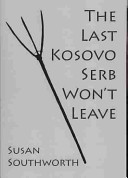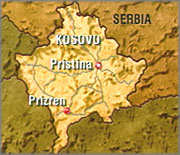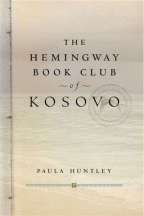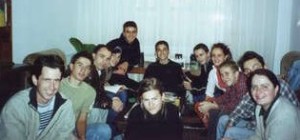April 28, 2012
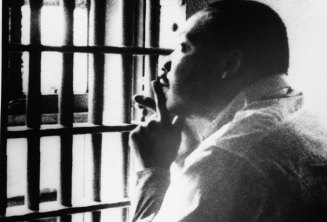
Dr. King in the Jefferson Co., AL Courthouse jail, Oct. 1967. During an earlier arrest, he wrote his famous letter from here. (Source: www.history.com)
Pleased by the students’ catching on so quickly to the power of rhetorical schemes and tropes, I asked them to turn next to the handout including Dr. King’s “Letter from Birmingham Jail.” To contextualize this famous essay, I contrasted King’s situation with Faulkner’s, the latter speaking from the “pinnacle” of high literary achievement, the former, 13 years after Faulkner’s speech, sitting in Birmingham’s jail for having led a protest march against segregation laws and practices. Pointing to additional rhetorical terminology on the board, I said that Faulkner’s situation, as we had seen, called for ceremonial discourse; in contrast, King’s situation called for “judicial discourse,” the kind of rhetoric that accuses the unjust and defends the just. But King also had to blend “deliberative discourse” with his judicial discourse, I argued, for he sought to dissuade Americans from tolerating racial discrimination and to advise Americans to live up to the high ideals of the country’s founding, especially the belief that “injustice anywhere is a threat to justice everywhere.” In other words, I explained, though King wrote nonfiction, he had the same goal that Faulkner urged novelists and poets to set, to ‘uplift the heart’ of a nation, to inspire his fellow citizens to endure and to prevail over the brutalities sanctioned by a racist culture.

Elements of Persuasion: Aristotle’s Rhetorical Triangle (Source: paulcharltoncoaching.com)
To achieve these dual aims of discourse, the judicial and the deliberative, King knew, I continued, that he would have to blend carefully the elements of persuasion. Clearly, his letter could begin with exposition. He would have to explain to his eight fellow clergymen, who condemned him in the local newspaper for his “unwise” and “untimely” demonstrations, why he had to leave Atlanta for Birmingham. Then reading from the handout from Questioning, I said that his exposition would also explain “why he had to break the law, why he could wait no longer for freedom. But he knew that mere exposition would not be enough; he would need to persuade the clergymen, his immediate audience, and the American people, his extended audience, that ‘injustice anywhere is a threat to justice everywhere,’ that the ‘stinging darts’ of segregation have made it impossible to wait any longer for freedom” (136).
Then I read one more excerpt from Questioning that provided a preface to our analysis:
To achieve his persuasive goal, he would have to provide plenty of logos, plenty of facts about his nonviolent movement, plenty of examples of lunch counters closed to black men and amusement parks closed to black children, plenty of cases of lynchings and drowning, plenty of testimony from prominent theologians who define segregation as “sin.” He would also have to temper his outrage over such cruelties with cool reason, stressing the illogic of writing laws that apply to some but not to all. Such logos, he knew, would build his ethos, his credibility, showing his skeptical audience that he knows the facts of injustice (informed), that he cares about his people’s long sufferings (generous), that he has told the truth about the brutal police. As a preacher, he knew, too, that he could further build his ethos with pathos, the appeal created by emotionally charged words and vivid imagery imbedded in rhythmic sentences, calling us all, black and white, to rise from “the dark depths of prejudice and racism to the majestic heights of understanding and brotherhood.” (137)
With King’s rhetorical purpose before us, I asked the students to look at King’s introduction, the first four paragraphs, to determine how he attempts to build his ethos in the presence of an immediate audience, the clergymen, who consider his persona to be entirely negative—an outsider, a trouble-maker, an instigator of “unwise” and “untimely” civic disturbances. “How does King show his generosity toward these men who have publicly condemned him?” I prompted. “Does he offer counter accusations?” Arben responded, saying that King responds to their polite hostility be crediting them with being “men of genuine good will” who therefore deserve to be answered in “patient and reasonable terms.”
Thanking Arben, I reminded the class that a positive ethos must seem informed and honest as well as generously disposed toward the audience. “How does King send these messages in paragraph two through four?” I inquired. Several students answered at once, mentioning King’s credentials as president of the Southern Christian Leadership Conference and his “organizational ties” to his Birmingham affiliates, who “invited” King to come, an invitation that never would have been sent, I commented, if he had no knowledge of Birmingham’s troubles or lacked the courage to help solve the problems.
“Then how does inject pathos, emotional appeal, in the next two paragraphs to underscore his honest, generous intentions?” I asked. Students quickly responded by noting the parallel sentences and the comparisons. Laureta said that by linking his “gospel of freedom” with that of the “prophets” and the “Apostle Paul,” King makes a comparison that clergymen would have to respect. Then I wrote on the board the sentence that follows his famous parallel sentence about injustice “anywhere” threatening justice “everywhere”: “We are caught in an inescapable network of mutuality, tied in a single garment of destiny.” “Can you explain how King intensifies these already strong parallel rhythms?” Xhemile answered my question, pointing to the metaphors imbedded in the parallel phrases, helping us to see the “network” we must preserve and the “garment” we must all wear to ensure a “destiny” of justice.
Congratulating the students on their astute readings, I then divided the class into three groups of five or six and assigned them further analytical tasks on the blending of ethos, logos, and pathos. After ten minutes of work, I called for a report from group one, who had been charged with paragraphs 6-11 and their contributions to ethos-building. This group then outlined King’s attempt to “negotiate with the city fathers” to get “racial signs removed,” then, once that process failed, the “self-purification” process that King and his followers underwent to prepare for “direct action,” a non-violent but dangerous way of challenging an unjust government that would likely respond with police dogs, batons, and jail. “So how does this use of logos, this evidence of his non-violent process of effecting positive change, build King’s ethos?” I wondered. Ragip responded by saying that this process shows King’s courage as well as his patience and reasonableness. “Yes,” I said, “and notice how he ends this section by injecting pathos again. How so?” Ragip followed up by noting the reference to Socrates, who also created “nonviolent tension” to liberate his people from “the bondage of myths and half-truths,” just as King and his people strive to “help men rise from the dark depths of prejudice and racism to the majestic heights of understanding and brotherhood.” Praising his habit of citation, I stressed once again that the emotional appeal comes from couching vivid metaphors within parallel sentence structures, juxtaposing the “dark depths” or racism with “majestic heights” of equality.
**Click on the first picture to scroll through the gallery images in a larger, “slideshow” format.**
- The Apostle Paul in Prison, Rembrandt van Rijn, oil on canvas, 1627 (Source: www.apostlepaul.net)
- The Death of Socrates, Jacques-Louis David, oil on canvas, 1787 (Source: Wikipedia)
- Saint Augustine (Source: www.catholic-forum.com)
- St. Thomas Aquinas (Source: http://www.marccortez.com)
- Judah Leon Magnes and Martin Buber testifying before the Anglo-American Committee of Inquiry in Jerusalem, 1946 (Source: Wikipedia)
- Paul Tillich (Source: http://www.allposters.com)
- Depiction of the Boston Tea Party (Source: king.portlandschools.org)
- Hungarian Freedom Fighter, Time Man of the Year, Time Magazine, Jan. 1957 (Source: Wikipedia)
- Christ Before Caiaphas, Mattias Stom, oil on canvas, early 1630s (Source: Wikipedia)
The next group, charged with finding more allusions, presented their list: St. Augustine, St. Thomas Aquinas, Martin Buber, Paul Tillich, the Boston Tea Party, the Hungarian freedom fighters, Jesus. “So do these historical and philosophical allusions represent ethos-building, logos, or pathos?” I asked. Hearing all three answers, I pronounced them all correct, explaining that each example of courageous resistance to tyranny counts as logos, and that such daring resistance stirs our emotions. “And how do the names of theologians build King’s ethos?” I pushed. Blerta answered that clergymen would respect the names of saints and that King did not just mention their names but quoted their advocacy for disobeying unjust laws. I praised her response and noted King’s wisdom in citing the Jewish philosopher Martin Buber and the Christian theologian Paul Tillich, both defining segregation as “morally wrong and sinful,” a reference, I said, that no doubt made King’s “dear fellow clergymen” squirm.
Finally, the third group reported on paragraphs 24-26, where King expresses his disappointment with the “white moderate,” the expediential cowards who support King’s cause with their words but never take action to help. The students found numerous examples of King’s blending of logos and pathos in his critique of these “lukewarm” allies, thereby strengthening his ethos as passionate and informed. First, they noted the parallel structures that repeat King’s frustration with the willful ignorance and inaction of the white moderates: “I had hoped that the white moderate would understand….Now is the time to make real the promise of democracy.” Commending their reading, I explained that this repetition of an opening structure of a sentence goes by the Greek term anaphora, and that it adds emotional intensity with its persistent beat: “Now is the time….Now is the time.” I then asked if they saw King’s method—a strategy we had seen before—of intensifying the beat, a prompt that quickly yielded King’s metaphors imbedded in the parallel sentences, the white moderates’ obstructions becoming a “dangerously structured dams that block the flow of social progress,” failures to “lift our national policy from the quicksand of racial injustice to the solid rock of human dignity.” I then asked why King used the disgusting “boil” simile. Hearing no answer, I asked, “What happens when a boil goes unlanced?” Besa responded that the infection can kill a person, precisely the point of King’s simile: if we fail to open the boil of segregation to “the air of national opinion,” the infection will spread through the national body and ultimately kill.
As the class prepared to leave, I asked them to re-read King’s letter, focusing this time on the part of logos we had not addressed yet, his use of inductive and deductive reasoning to strengthen his case and to move toward his meditational, peace-making goal. I reminded students, too, that they would find definitions and illustrations of induction, deduction, and meditational discourse in the handout from Questioning, 153-58.










